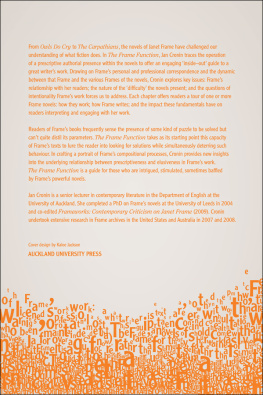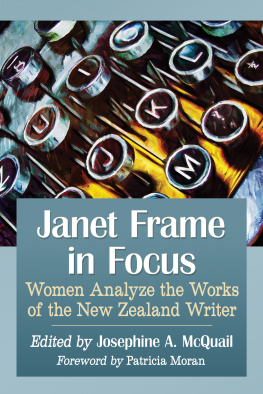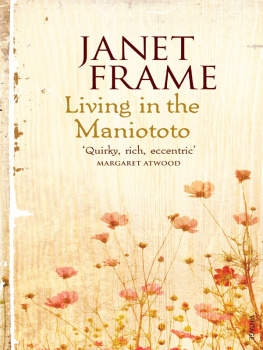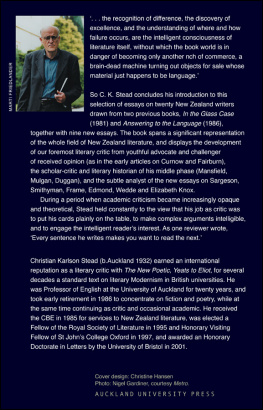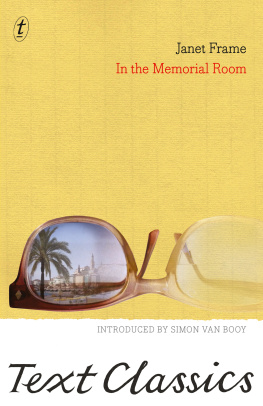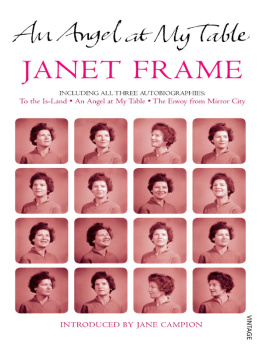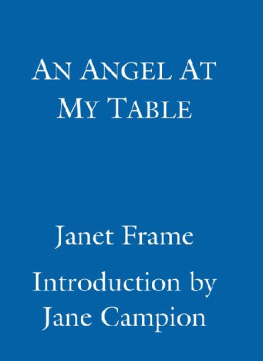

Copyright 2016 Janet Frame Literary Trust
Excerpts from Bill Browns letters Estate of William Theophilus Brown
All rights reserved under International and Pan-American Copyright Conventions. No part of this book may be used or reproduced in any manner whatsoever without written permission from the publisher, except in the case of brief quotations embodied in critical articles and reviews.
Library of Congress Cataloging-in-Publication Data is Available
Cover design by Kelly Winton
Interior design by Neuwirth & Associates
Counterpoint
2560 Ninth Street, Suite 318
Berkeley, CA 94710
www.counterpointpress.com
Distributed by Publishers Group West
10 9 8 7 6 5 4 3 2 1
e-book ISBN 978-1-61902-801-2
Table of Contents
Guide
CONTENTS


J anet Frames letters to Bill Brown (William Theophilus Brown), the Californian painter, written over two decades, are humorous and wide-ranging, revealing little known aspects of her creativity. She felt she had met her match in Brown, a painter, classical pianist and confidant of famous writers, musicians and artists. They met at the MacDowell artist colony in New Hampshire, USA, in late 1969, beginning a friendship that lasted until her death in 2004.
Frame wrote over 500 letters to Brown, from a rate of at least two a week in the first year to one a week for several years, dwindling to one every couple of months by the mid 1980s. The letters include observations of events and people, art and politics, philosophy and comedy, quotes from and parodies of poets such as Walt Whitman and Emily Dickinson, all intertwined with drawings, doodles and collages.
The bulk of the correspondence spans the decade of the 1970s during which Frame published Daughter Buffalo in 1972 and Living in the Maniototo in 1979. She poured so much dynamism and invention into this correspondence that it together with the novel In the Memorial Room (written in 1974 but not published until 2013) constitute the previously unknown masterpieces that fill what had seemed to some academic commentators to be a seven-year dry spell in Frames middle period. The swift changes of tone and structure of these letters arguably relate to and even prefigure the style of these novels. The letters also provide insights into her ideas and life, thus complementing her three volumes of autobiography published in the first half of the 1980s.
Frames letters to Brown combine many styles and registers of prose, poetry, drawings, illustrations, typographical flourishes and quotations. She implied they had the characteristics of collages when on thanking Brown in late June 1970 for his lovely letter and its enclosures she quoted a passage from W.H. Audens long poem Letter to Lord Byron that describes how exciting letters are full of enclosures such as gossip, cuttings and maps: they are a collage that you will read. Frame as early as her student years in the mid 1940s at Dunedin Teacher Training College was interested in the possibility of collage. A project entitled The Growth of Cities bored her until she realised that my only hope was to write (and illustrate) the long essay in my own way by fitting together various texts and images.
Frames friendship with the very well-read artist-musician Brown was a catalyst to her imagination. Her drawings and collages in her letters to him are most prolific during the early years, especially the first, the period of Jay to Bee. She sometimes claimed that she lacked any talent as an artist, but in these letters she expresses a personal style of drawing and design. Browns letters to her are similarly enlivened by humorous drawings. In later years, she did less art but sometimes included photographs in her letters to Brown, especially of her various houses and cats.
MACDOWELL AND YADDO ARTIST COLONIES
Frame first met Brown at MacDowell in New Hampshire, one of the most famous American artist colonies, where she stayed from mid-September to late November in 1969. She had a lot of fun as a member of a group that included Brown and the writers Jo Carson and Elnora Coleman. They dined and joked together as a reprieve from the earnest seriousness of other guests. They referred to themselves as the baby table and all kept in touch when they left. Two months after leaving MacDowell, Frame stayed a month at another major American artist colony, Yaddo, near Saratoga Springs in northern New York State.
This was her third visit there: her first stay was in May 1967, then subsequently from mid February to mid June 1969, October to December 1971, and February-March 1982. During the years 1967 to 1982, she spent a total of twelve months spread over six separate visits at these two artist colonies.
After leaving MacDowell and before going to Yaddo, Frame flew to California in early December to spend a week with Brown, then on to Baltimore to stay with her friend, John Money, a New Zealand born sexologist at Johns Hopkins University, whom she had known in New Zealand in the 1940s. She went to Yaddo in January 1970 and within a fortnight penned word portraits for Brown of fellow guests such as the composers Ned Rorem and Douglas Allanbrook, writers Ann Kazin and Norman Podhoretz and the critic Kenneth Burke. She formed a rapport with Burke, who one evening asked to see some of her poems and the next morning presented her with two pages of incisive critique. She was stimulated by these interactions but compared to the atmosphere of MacDowell felt, as she described in a letter to Brown, that
the formality of Yaddo makes it difficult for people to be themselves among one anotheryet this is no great disadvantage for ones work, and I think maybe it is an advantage; it means, though, that people get quickly stir crazy.
She wrote that she left Yaddo early, accompanying the literary critic Alfred Kazin, husband of her fellow guest Ann Kazin, on the bus down to New York, where she dined that evening with the Kazins at their apartment. She wrote to Brown:
I was glad to see the Kazins in real life because at Yaddo Ann was very-too-brilliant and witty, and Alfred seemed shyly disapproving, but in their home they were warm and happyits marvellous not to be conscious all the time that ones a writer.
During this period, she stayed with Elnora Coleman in her apartment in New York, then travelled to Baltimore to see John Money, whom she found less crabby than when I was last hereI think he is pleased with his series of lectures to the Medical students on Pornography.
RETURN TO NEW ZEALAND
In early March Frame flew to California for three weeks with Brown and his partner and fellow artist Paul Wonner, before continuing on the long trip back to New Zealand. Understandably, there was no correspondence during this time so there is a gap in the narrative of Jay to Bee, but the intense delight and stimulation of this visit can be inferred by the subsequent mutual flow of letters across the Pacific. On arrival in Auckland after a rough flight, she wrote to Brown in order to keep in touch, to remind myself of much happiness found at Hermosillo Drive: when I fall asleep I dream of it.


